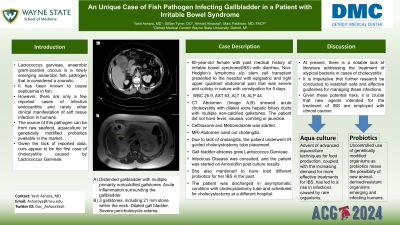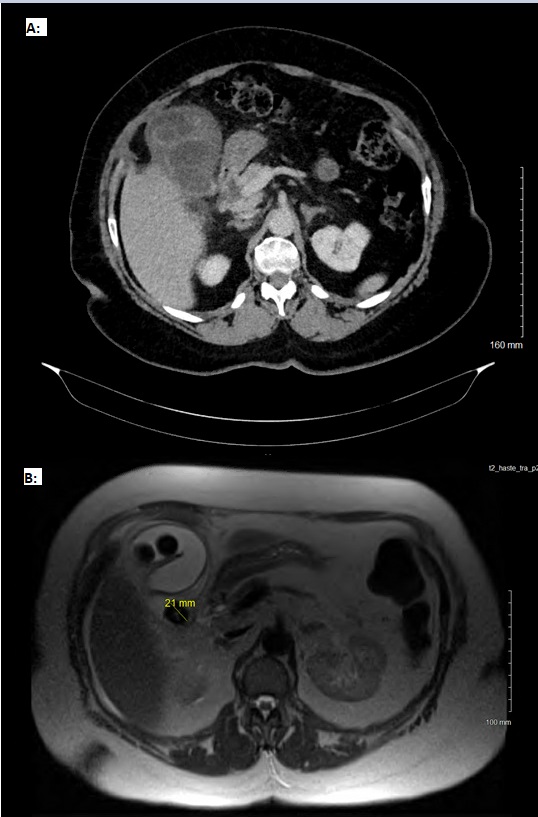Tuesday Poster Session
Category: Biliary/Pancreas
P3559 - A Unique Case of Fish Pathogen Infecting Gallbladder in a Patient with Irritable Bowel Syndrome
Tuesday, October 29, 2024
10:30 AM - 4:00 PM ET
Location: Exhibit Hall E

Has Audio
.jpg)
Yash P. Ashara, MBBS
Detroit Medical Center/Wayne State University
Detroit, MI
Presenting Author(s)
Yash P. Ashara, MBBS1, Gillian Tyner, DO1, Ahmad Alnasarat, MD2, Marc Fedlman, MD1
1Detroit Medical Center/Wayne State University, Detroit, MI; 2DMC Sinai-Grace Hospital, Farmington Hills, MI
Introduction: Lactococcus garvieae, a gram-positive coccus is a newly emerging anaerobic fish pathogen that is considered a zoonotic. It has been known to cause septicemia in fish. However, there are only a few reported cases of infective endocarditis and rarely other clinical manifestation of soft tissue infection in humans. The source of this pathogen can be from raw seafood, aquaculture or genetically modified probiotics available in the market. Given the lack of reported data, ours appear to be the first case of cholecystitis caused by Lactococcus Garvieae.
Case Description/Methods: 80-year-old female with past medical history of irritable bowel syndrome(IBS) with diarrhea presented to the hospital with epigastric and right upper quadrant abdominal pain that was severe and colicky in nature with constipation for 5 days. Her presentation labs were significant for elevated WBC 26.9, AST 63, ALT 16, ALP 44. CT Abdomen showed acute cholecystitis with dilated extra hepatic biliary ducts with multiple non-calcified gallstones. The patient did not have fever, nausea, vomiting or jaundice. The patient was started on Ceftriaxone and Metronidazole. MRI Abdomen was done to rule out cholangitis. Due to lack of cholangitis, the patient underwent IR guided cholecystostomy tube placement. The patient’s gall bladder abscess grew Lactococcus Garvieae. Infectious Disease was consulted, and the patient was started on Amoxicillin post culture results. She also mentioned to have tried different probiotics for her IBS in the past. The patient was discharged in asymptomatic condition with cholecystostomy tube and scheduled for cholecystectomy at different hospital.
Discussion: At present, there is a notable lack of literature addressing the treatment of atypical bacteria in cases of cholecystitis. It is imperative that further research be conducted to establish safe and effective guidelines for managing these infections. The advent of advanced aquaculture techniques for food production, coupled with the increasing demand for more effective treatments for IBS, has led to a rise in infections caused by rare organisms. There is a significant concern that bacteria from fish may pose a risk to humans through aquaculture practices. Additionally, the uncontrolled use of genetically modified organisms as probiotics raises the possibility of new animal-derived/resistant organisms emerging and infecting humans. Given these potential risks, it is crucial that new agents intended for the treatment of IBS are employed with utmost caution.

Disclosures:
Yash P. Ashara, MBBS1, Gillian Tyner, DO1, Ahmad Alnasarat, MD2, Marc Fedlman, MD1. P3559 - A Unique Case of Fish Pathogen Infecting Gallbladder in a Patient with Irritable Bowel Syndrome, ACG 2024 Annual Scientific Meeting Abstracts. Philadelphia, PA: American College of Gastroenterology.
1Detroit Medical Center/Wayne State University, Detroit, MI; 2DMC Sinai-Grace Hospital, Farmington Hills, MI
Introduction: Lactococcus garvieae, a gram-positive coccus is a newly emerging anaerobic fish pathogen that is considered a zoonotic. It has been known to cause septicemia in fish. However, there are only a few reported cases of infective endocarditis and rarely other clinical manifestation of soft tissue infection in humans. The source of this pathogen can be from raw seafood, aquaculture or genetically modified probiotics available in the market. Given the lack of reported data, ours appear to be the first case of cholecystitis caused by Lactococcus Garvieae.
Case Description/Methods: 80-year-old female with past medical history of irritable bowel syndrome(IBS) with diarrhea presented to the hospital with epigastric and right upper quadrant abdominal pain that was severe and colicky in nature with constipation for 5 days. Her presentation labs were significant for elevated WBC 26.9, AST 63, ALT 16, ALP 44. CT Abdomen showed acute cholecystitis with dilated extra hepatic biliary ducts with multiple non-calcified gallstones. The patient did not have fever, nausea, vomiting or jaundice. The patient was started on Ceftriaxone and Metronidazole. MRI Abdomen was done to rule out cholangitis. Due to lack of cholangitis, the patient underwent IR guided cholecystostomy tube placement. The patient’s gall bladder abscess grew Lactococcus Garvieae. Infectious Disease was consulted, and the patient was started on Amoxicillin post culture results. She also mentioned to have tried different probiotics for her IBS in the past. The patient was discharged in asymptomatic condition with cholecystostomy tube and scheduled for cholecystectomy at different hospital.
Discussion: At present, there is a notable lack of literature addressing the treatment of atypical bacteria in cases of cholecystitis. It is imperative that further research be conducted to establish safe and effective guidelines for managing these infections. The advent of advanced aquaculture techniques for food production, coupled with the increasing demand for more effective treatments for IBS, has led to a rise in infections caused by rare organisms. There is a significant concern that bacteria from fish may pose a risk to humans through aquaculture practices. Additionally, the uncontrolled use of genetically modified organisms as probiotics raises the possibility of new animal-derived/resistant organisms emerging and infecting humans. Given these potential risks, it is crucial that new agents intended for the treatment of IBS are employed with utmost caution.

Figure: A: Distended gallbladder with multiple primarily noncalcified gallstones. Acute inflammation surrounding the gallbladder.
B: 3 gallstones, including 21 mm stone within the neck. Dilated gall bladder. Severe pericholecystic edema.
B: 3 gallstones, including 21 mm stone within the neck. Dilated gall bladder. Severe pericholecystic edema.
Disclosures:
Yash Ashara indicated no relevant financial relationships.
Gillian Tyner indicated no relevant financial relationships.
Ahmad Alnasarat indicated no relevant financial relationships.
Marc Fedlman indicated no relevant financial relationships.
Yash P. Ashara, MBBS1, Gillian Tyner, DO1, Ahmad Alnasarat, MD2, Marc Fedlman, MD1. P3559 - A Unique Case of Fish Pathogen Infecting Gallbladder in a Patient with Irritable Bowel Syndrome, ACG 2024 Annual Scientific Meeting Abstracts. Philadelphia, PA: American College of Gastroenterology.

